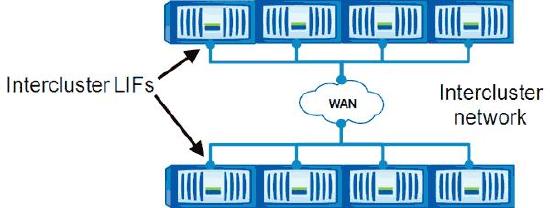What is an Intercluster network?
Applies to
- ONTAP 9
Answer
When a cluster peering is set up, the relationship between two clusters is configured over the Intercluster network. Cluster peering is necessary for solutions that require data to be sent from one geographical location to another, such as replication for disaster recovery, because all nodes in the same cluster must be geographically collocated. This means that volumes on nodes in different geographical locations must belong to different clusters. To enable communication between the two clusters, the Intercluster network has to be configured.
Peer relationships can be configured for a single cluster with up to eight remote clusters. Each cluster peer relationship must be created separately. After a peer relationship is created, data can be sent in either direction between the two clusters in that peer relationship. A peer relationship is required for data to be sent in either direction between two clusters.
The Intercluster network uses logical interfaces, or LIFs, that correspond to IP addresses and represent network access points to a node. The Intercluster network uses only Intercluster LIFs. Intercluster LIFs are assigned to ports as part of the cluster peer configuration process.

The following are requirements for Intercluster LIFs:
- At least one Intercluster LIF must be configured on every node in the local cluster, and on every node in the remote cluster. Provisioning Intercluster LIFs on only some nodes of the cluster is not supported.
- Each Intercluster LIF requires an IP address dedicated for Intercluster communication. The IP addresses assigned to Intercluster LIFs can reside in the same subnet as data LIFs or in a different subnet.
- Every Intercluster LIF on every node of the local cluster should be able to connect to every Intercluster LIF on every node of the remote cluster.
The cluster peering topology should use full-mesh connectivity. Full-mesh connectivity means that all the Intercluster LIFs of one peer cluster can communicate with all of the Intercluster LIFs of the other peer cluster.
Related Links:
Additional Information
Add your text here.
